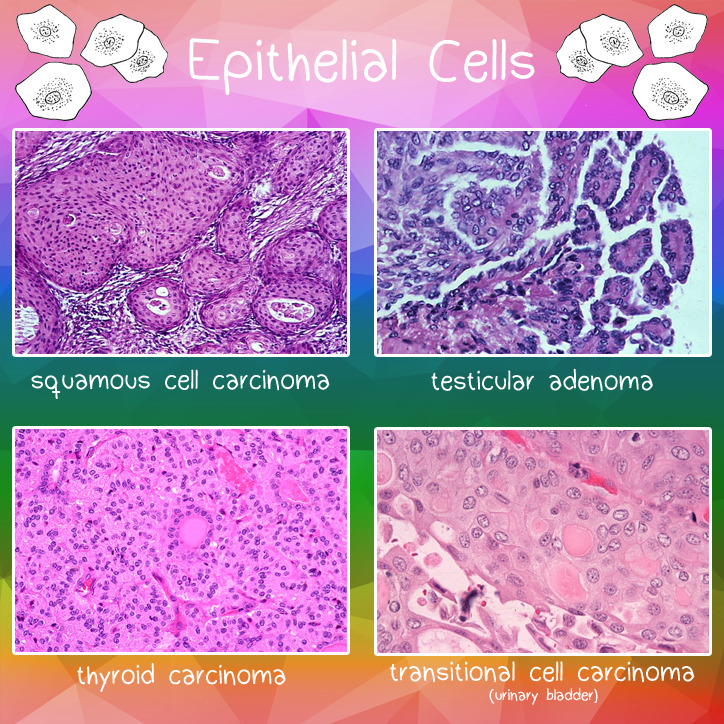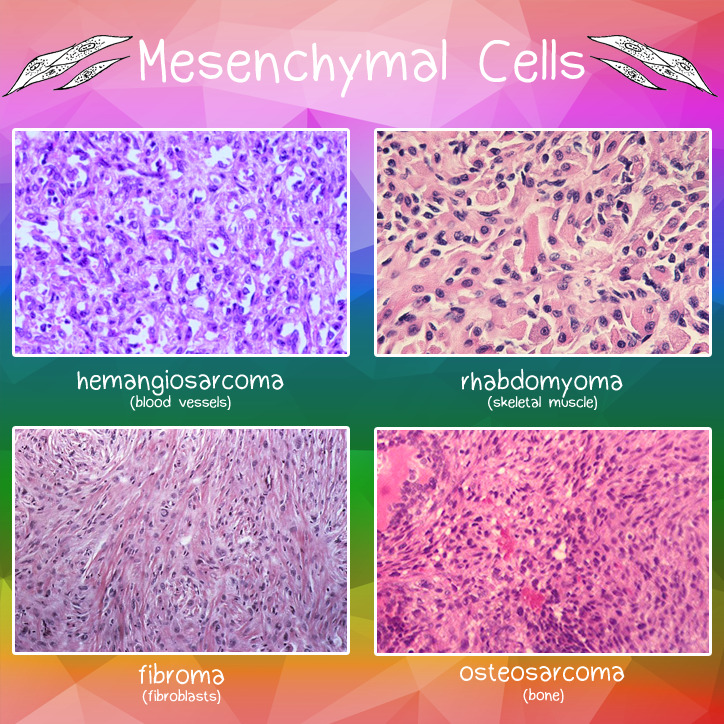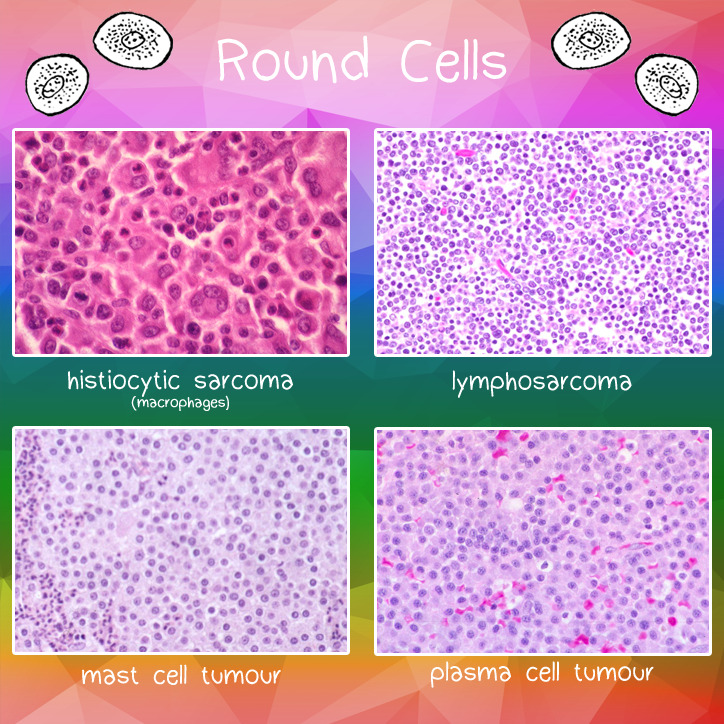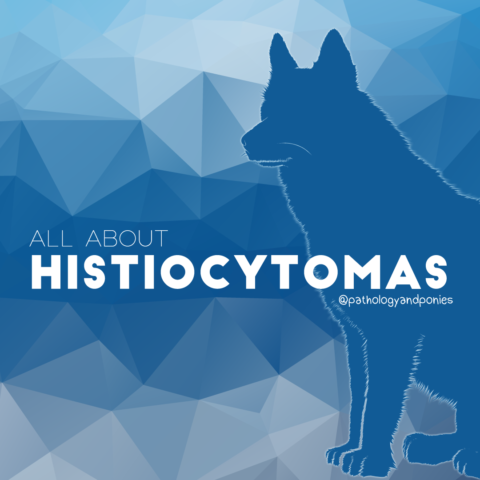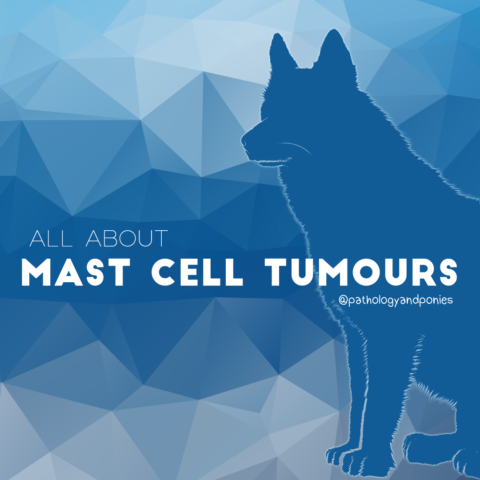It’s P+P’s birthday! Here’s to one year of interesting diseases! Today I thought it would be fun to learn about the basic types of tumours. There is also a quiz below if you want to test out your histopathology skills!
𝐓𝐮𝐦𝐨𝐮𝐫𝐬 𝐡𝐚𝐯𝐞 𝐭𝐲𝐩𝐞𝐬?
Yes! Tumours are basically just an excessive proliferative of a group of cells, due to the cells losing the “brakes” on their growth and cell division. Each tissue has a variety of cell types within it, and any of these cells can potentially develop into a tumour. This is why there are so many different kinds of cancer!
There are actually three types of cells that tumours most commonly arise from: 𝐞𝐩𝐢𝐭𝐡𝐞𝐥𝐢𝐚𝐥 𝐜𝐞𝐥𝐥𝐬, 𝐦𝐞𝐬𝐞𝐧𝐜𝐡𝐲𝐦𝐚𝐥 𝐜𝐞𝐥𝐥𝐬 and 𝐫𝐨𝐮𝐧𝐝 𝐜𝐞𝐥𝐥𝐬. We use the cell of origin and its 𝐦𝐚𝐥𝐢𝐠𝐧𝐚𝐧𝐜𝐲 (how nasty it is) to name the tumour, which is pretty handy! This means that if you have the name of the tumour, you can generally figure out what cell type it came from, and how bad it is.
𝐄𝐩𝐢𝐭𝐡𝐞𝐥𝐢𝐚𝐥 𝐂𝐞𝐥𝐥𝐬
Epithelial cells are 𝐥𝐢𝐧𝐢𝐧𝐠 cells, and can be found all over the body! The most common epithelial cell populations are the 𝐬𝐤𝐢𝐧, the lining of the 𝐠𝐚𝐬𝐭𝐫𝐨𝐢𝐧𝐭𝐞𝐬𝐭𝐢𝐧𝐚𝐥 𝐭𝐫𝐚𝐜𝐭 and the lining of the 𝐫𝐞𝐬𝐩𝐢𝐫𝐚𝐭𝐨𝐫𝐲 𝐭𝐫𝐚𝐜𝐭. Their main purpose is to regulate the flow of materials from an open area (like the inside of the gut) into the body. These cells have a characteristic 𝐩𝐨𝐥𝐲𝐠𝐨𝐧𝐚𝐥, or rectangular, shape to them.
To name these tumours, we first decide if they are 𝐛𝐞𝐧𝐢𝐠𝐧 (not too angry) or 𝐦𝐚𝐥𝐢𝐠𝐧𝐚𝐧𝐭 (angry), then what the epithelial cell population they came from is. If they are benign, we call them an 𝐚𝐝𝐞𝐧𝐨𝐦𝐚. If they are malignant, a 𝐜𝐚𝐫𝐜𝐢𝐧𝐨𝐦𝐚. So for example, if we had a malignant tumour of the 𝐬𝐪𝐮𝐚𝐦𝐨𝐮𝐬 𝐜𝐞𝐥𝐥𝐬of the skin surface, we would call it a 𝐬𝐪𝐮𝐚𝐦𝐨𝐮𝐬 𝐜𝐞𝐥𝐥 𝐜𝐚𝐫𝐜𝐢𝐧𝐨𝐦𝐚.
𝐌𝐞𝐬𝐞𝐧𝐜𝐡𝐲𝐦𝐚𝐥 𝐂𝐞𝐥𝐥𝐬
Mesenchymal cells are the structural cells that make up the majority of tissues. Even tissues like bone, fat and cartilage are considered to be mesenchymal! These cells are typically 𝐬𝐩𝐢𝐧𝐝𝐥𝐞 shaped, meaning elongated with thinned ends.
These tumours are named in a similar fashion, but using suffixes. For example, a benign mesenchymal tumour arising from the fat (𝐥𝐢𝐩𝐢𝐝) is called a 𝐥𝐢𝐩𝐨𝐦𝐚. So the suffix -oma is added to the tissue name. A malignant tumour of the fat would be called a 𝐥𝐢𝐩𝐨𝐬𝐚𝐫𝐜𝐨𝐦𝐚, adding the suffix -sarcoma.
𝐑𝐨𝐮𝐧𝐝 𝐂𝐞𝐥𝐥𝐬
The round cells are better known as 𝐰𝐡𝐢𝐭𝐞 𝐛𝐥𝐨𝐨𝐝 𝐜𝐞𝐥𝐥𝐬, and have a characteristic 𝐫𝐨𝐮𝐧𝐝 shape as you might have guessed from the name! These cells make up the majority of our immune system, and can be found patrolling all tissues of the body looking for invaders.
As far as naming goes, tumours of these cells are almost always considered to be malignant. One of the main features of malignancy is 𝐦𝐞𝐭𝐚𝐬𝐭𝐚𝐬𝐢𝐬, or spreading to other tissues via the bloodstream or lymphatics. In the case of round cells… they’re already within the bloodstream! So they are bad news bears right from the start.
Technically, they are part of the mesenchymal cell family, even though we consider them to be a different cell population. So, they have a similar naming scheme to the mesenchymal cells. For example, a tumour of the 𝐥𝐲𝐦𝐩𝐡𝐨𝐜𝐲𝐭𝐞𝐬 is called a 𝐥𝐲𝐦𝐩𝐡𝐨𝐬𝐚𝐫𝐜𝐨𝐦𝐚. Pathologists are often lazy though so you may hear it referred to as a 𝐥𝐲𝐦𝐩𝐡𝐨𝐦𝐚, even though this implies that this tumour is benign.
𝐏𝐡𝐨𝐭𝐨𝐬
1-3) Examples of tumours arising from the different cell populations! If you think you can tell them apart, try the quiz on our website 😁
𝐒𝐨𝐮𝐫𝐜𝐞𝐬
Zachary JF. Pathologic Basis of Veterinary Disease, Sixth Edition.
Photos © Noah’s Arkive contributors Harvey/Raskin, Yin, Knoll, Harmon, Sagartz, Wells, King, Howard, Domingo licensed under CC BY-SA 4.0.
Photos © Noah’s Arkive contributors Ward, Harmon, Luginbuhl, Ramos, Wells, Hall, Dick, Knoll, King, Hafner/Hill, Eastep, Kazocos, Ramos-Vera, Rech, Bryan licensed under CC BY-SA 4.0.

